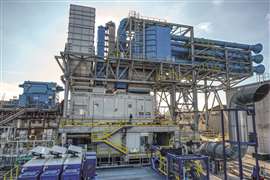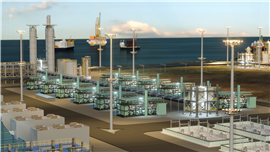Processing LNG: all plants, large and small
08 June 2023
Along with new technology and construction trends for LNG plants, Baker Hughes discussed with CT2 its advancements in flexible, modular solutions
 The LM9000 aeroderivative gas turbine with 73.5 MW power output at ISO conditions reaches about 44% efficiency in simple cycle and 56% in cogeneration mode. It can offer operators increased availability thanks to the reduced number of start-stop cycles and maintenance times. De Renzis said that Baker Hughes expects that the LM9000 will be one of the aeroderivative turbines of choice for floating LNG applications.
The LM9000 aeroderivative gas turbine with 73.5 MW power output at ISO conditions reaches about 44% efficiency in simple cycle and 56% in cogeneration mode. It can offer operators increased availability thanks to the reduced number of start-stop cycles and maintenance times. De Renzis said that Baker Hughes expects that the LM9000 will be one of the aeroderivative turbines of choice for floating LNG applications.
There is no big doubt that the market for LNG is currently going through a clear growth curve worldwide.
Maria De Renzis, Strategy & Growth director, Gas Technology- Equipment, Industrial & Energy Technology (IET) at Baker Hughes, commented that the fact the LNG market is experiencing a great conjuncture is backed up also by the figures related to new projects worldwide: “Year 2022 closed with 36 MTPA in new LNG projects and 2023 is likely to overcome this level. For the coming three years, 100 to 150 MTPA are expected to be added to production.”
A specialist in LNG trends, Enrico Calamai, LNG Strategic Growth Manager, Gas Technology- Equipment, Industrial & Energy Technology (IET) at Baker Hughes, explained that this market situation has brought along a new approach to project execution: “While in the past projects were usually stick-built with lots of components shipped separately and assembled on site, now we are seeing an increased interest in a modular approach with pre-assembled systems delivered and connected on site with a more limited effort in time and manpower.”
According to Calamai, this new methodology is also connected to the difficulty of recruiting expert manpower in a lot of places around the world and with the fact that LNG resources are more and more explored in very remote areas. “There is also an advantage in reducing site risks; ultimately, a modular approach is beneficial both in terms of costs and of delivery time.”
“Modularization and standardization also allow to approach a new project in phases, allowing the customer to start with smaller projects and keep the possibility of future expansions while the first modules are already commissioned,” added De Renzis.
Baker Hughes is not new to the modular approach and has more than 30 years’ experience in modularization with production in dedicated yards in its Avenza plant, not far from the Florence headquarters in Italy.
 Calamai pointed out that the 1-MTPA range LNG Module is a solution for onshore plants and can operate with a quite broad spectrum of gas qualities. It is ideal for LNG reserves which are too small for traditional large-scale projects; the system is quickly commissioned and can be scaled up by adding more modules at any time.
Calamai pointed out that the 1-MTPA range LNG Module is a solution for onshore plants and can operate with a quite broad spectrum of gas qualities. It is ideal for LNG reserves which are too small for traditional large-scale projects; the system is quickly commissioned and can be scaled up by adding more modules at any time.
“In the past, modulization was tailored-made for specific customers’ needs,” said Calamai. “Today it is becoming the dominating standard.” He added that, in this respect, the market of LNG has changed radically: “In the past, projects were developed mostly on the basis of existing references and with minor changes between one project and the other; lately there is a clear trend to studying completely new projects and exploring different ways of building.”
According to De Renzis, current technology trends in equipment for the LNG market can be summarized under two main topics: increased efficiency and reduction of environmental impact. She said: “Baker Hughes’ strengths for the LNG market have always been its capacity to adapt and to offer solutions that are optimized for each single project.
“Following the trend for modularization and plug&play solutions, Baker Hughes is offering its new 1-MTPA range LNG Module, a solution with a production capacity of 0.8 to a million-ton LNG per year from a footprint of just 1,300 m2 for the whole solution, fully designed and produced by Baker Hughes,” said Calamai.
“This solution is very flexible and can use an electric motor or a turbine as a driver, to be positioned outside the module,” he added. “Choosing one driver or the other won’t impact the size of the module itself. In case an electric motor is chosen as a driver, we can offer a 40-MW-class fixed-speed unit that comes with its soft start.”
Calamai explained that the 1-MTPA range LNG Module is composed of five packages: the process module; the rotation equipment (the compressor skid with its driver); the surge vessel for the refrigeration storage; the cold box for LNG production; and a small electric house for the electric motor soft starter.
This solution can be perfectly coupled with a Combined Heat and Power (CHP) power generation cycle based on the LM9000 gas turbine, thus allowing easy integration with electricity from renewable sources.
STAY CONNECTED




Receive the information you need when you need it through our world-leading magazines, newsletters and daily briefings.
POWER SOURCING GUIDE
The trusted reference and buyer’s guide for 83 years
The original “desktop search engine,” guiding nearly 10,000 users in more than 90 countries it is the primary reference for specifications and details on all the components that go into engine systems.
Visit Now
CONNECT WITH THE TEAM









